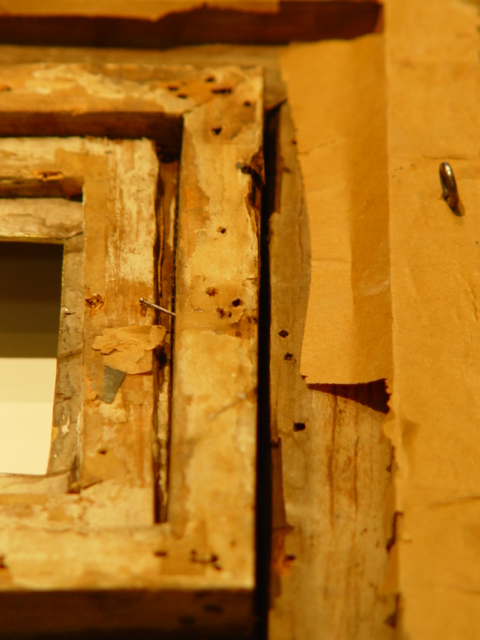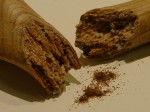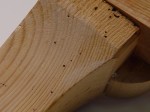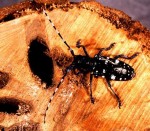How to Prevent Insects From Eating Fine Art Canvas Paintings

Damage done by insects to the frame and stretcher of an oil painting.
I accept had customers come to me with oil painting on which they recently noticed minor holes developing nigh the edges of the canvass and also found small piles of woods dust on the floor under the paintings. They took the paintings off the wall and discovered that the back of the frames and stretchers had been eaten by some blazon of insect or termite.
Some household insects are attracted to organic ( not-living ) materials that are normally used to create furniture, paintings, works on newspaper and sculpture. These pests tin easily enter your home and feed on wood, gum, paper, linen, wool, cotton, leather, horn and feathers, and it is best to defend your art, antiques and collectibles against these art-loving pests.
There are two types of insects that destroy woods, those that attack fresh wood ( trees and fresh wood in storage ) and those that attack dry worked forest. They tin remain active in the same piece of wood long enough to completely swallow it. Ofttimes times, they will tunnel through a support leg or side panel on a piece of furniture, causing extensive structural harm. Their caustic work usually goes unnoticed until after much of the damage has already been done.
Only a few types of insects have an appetite for dry worked wood plant in furniture, stretchers for paintings and picture frames. The most mutual are the woodworm or furniture protrude ( Anobium punctatum ), the long-horn house protrude ( Hylotrupes bajulus ) and the powder postal service beetle ( Lyctus brunneus ), including their relatives. Most wood-wearisome insects accept life cycles of only a few years. They develop and modify in 4 stages known equally metamorphosis ( egg, larva, pupa, adult insect ). The larvae that hatch from eggs bore their way through wood, grinding it up and sometimes actually eating it.
Pieces of chewed woods and waste particles combine to course diameter dust ( frass ), which is often species-specific in color and shape, allowing experts to identify the type of infestation. This sawdust or sand-like material tin ordinarily exist constitute well-nigh where the fully formed beetle emerges through the bore or flight holes into the open air. Flying holes are a articulate indication of previous or active infestation, requiring an inspection to determine if treatment or structural restoration is needed. Furniture beetles are attracted to softer woods in areas where temperatures are warm and humidity levels are high, while powder post beetles prefer a dry out, warm environment to feed on starch and poly peptide.
What to Wait For:

Wood eaten away by insects can ruin antiques, weakening legs and supports until they break completely through.
Many insects are reclusive and are difficult to discover because of their size and color. Look for insect remains, empty egg cases, termite wings, casings or skins that have been shed by larvae.
WOOD: Await for bore holes and sawdust. Lightly tap areas of wood where infestation is suspected with your finger tip to observe hollow areas that may accept been tunneled or eaten by insects.
TEXTILES: Look for small holes and areas that have become unusually sparse.
PAPER: Look for small holes, tattered edges and areas where the paint or color appears to be abraded or erased. The abrasion tin exist caused by silverfish every bit they travel across the surface of a print, painting or certificate.
PAINTINGS: Look for small holes on the surface of the sail, or diameter/exit holes in panels, stretchers and frames. Many times insect remains are institute in spider webs on the dorsum of the painting. Small wing "specks" or droppings are commonly found on the surface of a painting and can be safely removed by an experienced restorer.
What to do if You Find Insect Harm:

Bore holes show where an infestation has taken place.
Isolate the object by placing it in a sealed plastic bag or wrap to forbid the insects from spreading to other objects while y'all seek assist.
Collect and preserve samples of any insect remains and diameter-hole dust for inspection by an experienced art and piece of furniture restorer or conservator and exterminator.
Do not spray pesticides directly on treasured objects of art or antiques, as they tin can stain, discolor and damage the surface or finish.
Some objects like forest and paper can be frozen to kill adult insects, larvae and eggs. Do not freeze paintings, photographs, lacquered surfaces or layered items.
Prevention Tips:

Keep your house and storage areas make clean: Insects thrive on dusty, muddied and dark environments.
At that place are a number of practical measures that individuals can take to preclude an infestation in their home or function:
• Make sure that window and door screens prevent insects from entering;
• Practice not bring outdoor plants into your abode;
• Keep your house and storage areas clean: Insects thrive on dusty, dirty and night environments;
• Lower the temperature and humidity levels, and increase air circulation;
• Art and antique items, documents and photographs that are stored should be kept in clean, closed plastic containers in a controlled environment.
—by Douglas Eisele
Old World Restorations
WorthPoint—Discover Your Hidden Wealth
Bring together WorthPoint on Twitter and Facebook.
(Visited 973 times, 1 visits today)
Source: https://www.worthpoint.com/articles/blog-entry/insects-can-destory-art-antique-treasures
0 Response to "How to Prevent Insects From Eating Fine Art Canvas Paintings"
Post a Comment